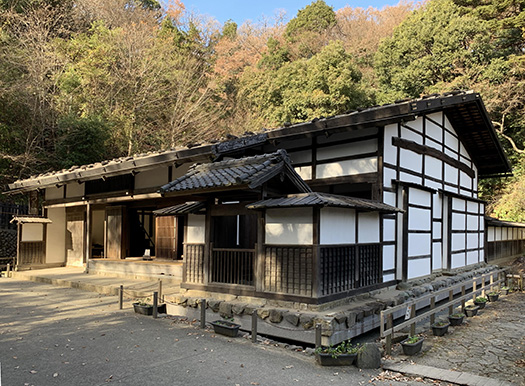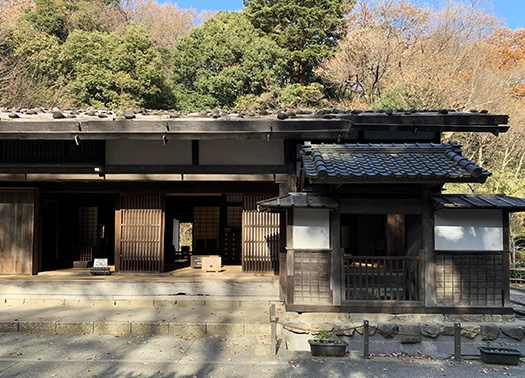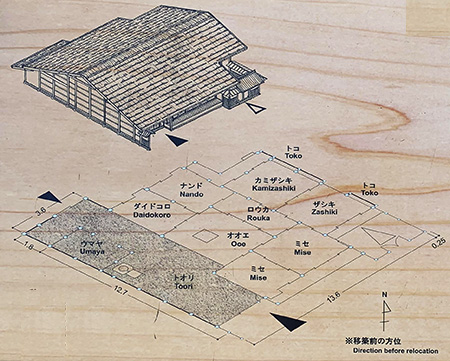


昨日から取り上げている長野県伊那の旧三澤家住宅その2です。
日本の庶民の住宅・民家では、その「生業」が住宅のありようを
強く規定していて人々の必死な生き様が立ち上ってくる。
民家を見つめることはそのまま「民俗」の姿を具体的に捉えることに繋がる。
わたしは住宅雑誌を創刊して以来、ずっとそういう住宅の「息づかい」に触れてきた。
住宅建築とは結局、その建て主の生き方暮らし方の表現されたもの。
「いい家」とは、その人の暮らし方と似合い支えていると感じられる家なのだと思う。
そんなことから、全国各地に残る民家探訪はライフワークとも思える次第。

そういういわば「生業探究」みたいなテーマでは
この三澤家住宅はきわめて特徴的だと思います。
基本は地域を代表する大農家であり、小作200家を擁している。
しかし、その基本の生業に加えて薬製造販売業と旅籠まで営んでいる。
旅籠ではかなりの有力者も宿泊する「格式」も持っていた。
それらの複層的な生業が、それぞれの「玄関」として3つの機能に分かれている。
写真一番上では、高級旅宿として立派な「門構え」、なかには式台玄関も備えている。
旅客のなかの賓客については、この玄関奥の上座敷や座敷に通して接遇していた。
儒教的格式的な「身分格差」の建築的表現が端的に表される。
庭も造作されて「結構」がしつらえられている。
下の写真は「上座敷き」の様子。簡易ですが床の間・書院もある。

その左手は、薬の製造販売に関わる商家の「ミセ」構え。
三澤家では材料を木曽の薬種商から仕入れ、敷地内にあった「薬倉」で
薬研などを使って調合していたとされる。こちらでは製造すると同時に
小売もされていたし、さらに柳行李を背負って行商して歩く富山の薬売りの
商法まで行っていたということ。販売範囲は広く長野・名古屋・東京・栃木と広範囲。
東京銀座の有名薬店には「養血圓」というブランド薬も卸していた。
さらに下の写真では、所有土地6万坪という大農家の経済を仕切る入口が開口する。
きのう書いたように小作たちの生産米が牛車でそのまま通り土間を通って
奥の倉に収納されていたということ。
そういった収納管理のために入口付近の「ミセ」で管理事務が執り行われた。
日本の庶民がいかに「士農工商」などという身分制に縛られていなかったか、
経済活動に邁進していたかが、まざまざと活写されている。
アジアでもっとも発達した「封建制度」のなかで、
各地域が経済発展し、活発な生産流通が旺盛に繰り広げられていた。
武家権力によって「平和」が実現したことで可能になったことですが、
同時にこの発展ぶりが武家政権の限界をさらけ出していったことも事実。
まことに旺盛な江戸期の民の経済実態が見えてくる。・・・
The English version is here.
[Private house with different livelihood at each entrance / Good Japanese house ⑰-2]
Within the rule of the samurai family during the Edo period, there was active economic promotion of the people, and “repairing the world” became inevitable. Overwhelmed by the development reality of livelihood.・ ・ ・
It is the former Misawa family house 2 in Ina, Nagano prefecture.
In the housing and private houses of the common people in Japan, the “living business” is what the housing should be.
It is strongly regulated and people’s desperate way of life rises up.
Looking at a private house directly leads to a concrete picture of “folk”.
Ever since I launched the housing magazine, I have been exposed to the “breathing” of such housing.
After all, housing construction is an expression of the owner’s way of life.
I think that a “good house” is a house that suits and supports the way of life of the person.
For that reason, exploring private houses that remain all over the country seems to be a life work.
So to speak, in a theme like “inquiry for livelihood”
I think this Misawa family house is extremely distinctive.
Basically, it is a large farmer representing the area and has 200 peasants.
However, in addition to its basic livelihood, it also runs a drug manufacturing and sales business and a hatago.
Hatago also had a “formality” where quite a few influential people stayed.
These multi-layered livelihoods are divided into three functions as their “entrances”.
At the top of the photo, there is a magnificent “gate stance” as a luxury inn, including a ceremonial hall entrance.
Among the passengers, the guests were treated through the upper tatami room and tatami room at the back of the entrance.
The architectural expression of the Confucian formal “status gap” is simply expressed.
The garden is also constructed and “quite” is prepared.
The photo below shows the “Kamizashiki”. It’s simple, but there is also a tokonoma and a shoin.
On the left is the “Mise” stance of a merchant involved in the manufacture and sale of medicines.
At the Misawa family, materials are purchased from a drug dealer in Kiso, and at the “Yakukura” on the premises.
It is said that it was prepared using Yagen. At the same time as manufacturing here
It was also retailed, and Toyama’s drug dealer who peddled with Yanagi Yuki Lee on his back
It means that he went to the commercial law. The sales range is wide, including Nagano, Nagoya, Tokyo, and Tochigi.
A famous drugstore in Ginza, Tokyo, also wholesaled a branded drug called “Blood-feeding Yuan”.
Furthermore, in the photo below, the entrance that divides the economy of a large farmer with a land of 60,000 tsubo opens.
As I wrote yesterday, the rice produced by the peasants passes through the dirt floor as it is in an ox cart.
It was stored in the back storehouse.
For such storage management, administrative work was carried out at “Mise” near the entrance.
How the Japanese people were not tied to the social division system such as “Four occupations”
Whether or not he was striving for economic activity is clearly captured.
Among the most developed “feudal systems” in Asia
Each region was economically developed, and active production and distribution were actively carried out.
It was made possible by the realization of “peace” by samurai power,
At the same time, it is also true that this development has exposed the limits of the samurai government.
You can see the economic reality of the people of the Edo period, which was really vigorous.・ ・ ・
Posted on 1月 10th, 2021 by 三木 奎吾
Filed under: 住宅マーケティング, 日本社会・文化研究, 歴史探訪








コメントを投稿
「※誹謗中傷や、悪意のある書き込み、営利目的などのコメントを防ぐために、投稿された全てのコメントは一時的に保留されますのでご了承ください。」
You must be logged in to post a comment.